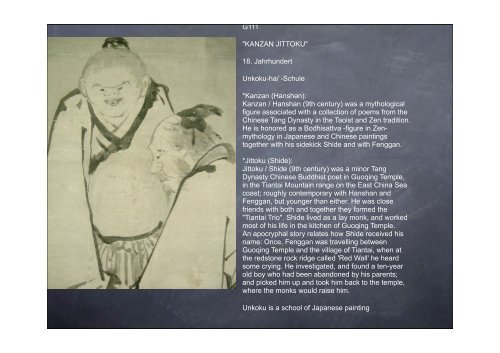ENSO - DER KREIS The ultimate symbol of Zen art is ... - Wieninger
ENSO - DER KREIS The ultimate symbol of Zen art is ... - Wieninger
ENSO - DER KREIS The ultimate symbol of Zen art is ... - Wieninger
You also want an ePaper? Increase the reach of your titles
YUMPU automatically turns print PDFs into web optimized ePapers that Google loves.
G111"KANZAN JITTOKU"18. JahrhundertUnkoku-ha/ -Schule*Kanzan (Hanshan):Kanzan / Hanshan (9th century) was a mythologicalfigure associated with a collection <strong>of</strong> poems from theChinese Tang Dynasty in the Tao<strong>is</strong>t and <strong>Zen</strong> tradition.He <strong>is</strong> honored as a Bodh<strong>is</strong>attva -figure in <strong>Zen</strong>mythologyin Japanese and Chinese paintingstogether with h<strong>is</strong> sidekick Shide and with Fenggan.*Jittoku (Shide):Jittoku / Shide (9th century) was a minor TangDynasty Chinese Buddh<strong>is</strong>t poet in Guoqing Temple,in the Tiantai Mountain range on the East China Seacoast; roughly contemporary with Hanshan andFenggan, but younger than either. He was closefriends with both and together they formed the"Tiantai Trio". Shide lived as a lay monk, and workedmost <strong>of</strong> h<strong>is</strong> life in the kitchen <strong>of</strong> Guoqing Temple.An apocryphal story relates how Shide received h<strong>is</strong>name: Once, Fenggan was travelling betweenGuoqing Temple and the village <strong>of</strong> Tiantai, when atthe redstone rock ridge called 'Red Wall' he heardsome crying. He investigated, and found a ten-yearold boy who had been abandoned by h<strong>is</strong> parents;and picked him up and took him back to the temple,where the monks would ra<strong>is</strong>e him.Unkoku <strong>is</strong> a school <strong>of</strong> Japanese painting


